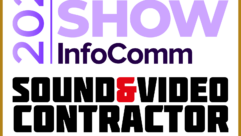High lumen projection has always had a special place in the staging world. There is something awe-inspiring if not magical about bringing the kind of big-screen fireworks that were once reserved for cinema-sized screens to the live corporate event, or concert, or Broadway production. And while the high lumen video projector still reigns as a top tool for staged events, and in fact new generation video projectors are bringing new feature sets to the market– direct view LED is coming on strong. As Alan Brawn and I address in the cover story of this issue, the video landscape is changing, and much of the change is in the LED camp, as new technology comes to market that is applicable not just for traditional “stage” settings like IMAG but for the increasing use of screens in new places and new ways– temporary broadcast sets for events of all kinds, trade show booths, lobby or other off-stage areas of events, breakout rooms, and more.
Remember when the big auto shows sucked up all the LED in the country at once, and dictated a lot of market dynamics? Those days are over, replaced by a steady stream of LED for diverse applications and events throughout the year. The Olympics in Korea had a lot of LED, and the temporary locations produced challenges similar to one-off live events.
The large format display (LFD) market is expected to reach USD $14.93 billion by 2023, at a CAGR of 6.7% between 2017 and 2023. Pretty significant growth. And direct view LED will eventually catch up to if not overtake LCD video walls: currently making up just 19% of today’s global market for large format (non-projection) display (LFD); narrow pixel pitch LED is challenging the status quo and is expected to rise to 44% market share by 2020. The cover story in this issue shows how the staging community is contributing to this trend–with creative and interesting results.
Speaking of creativity, Les Goldberg in his column, warns against the dangers of staging companies getting sucked into thinking they are show producers as well. Goldberg points out how production teams and staging companies just have different ways of thinking–with a great staging company focused on how to execute a show in the most cohesive and efficient way possible. Focus is important, according to Goldberg, and in general sticking with your strengths is the best business strategy.










